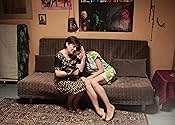Die Geschichte spielt im Jahr 2010, in einem postkommunistischen Rumänien, in das einige derjenigen, die die kommunistische Zeit vollständig miterlebt haben, nicht mehr zu passen scheinen.Die Geschichte spielt im Jahr 2010, in einem postkommunistischen Rumänien, in das einige derjenigen, die die kommunistische Zeit vollständig miterlebt haben, nicht mehr zu passen scheinen.Die Geschichte spielt im Jahr 2010, in einem postkommunistischen Rumänien, in das einige derjenigen, die die kommunistische Zeit vollständig miterlebt haben, nicht mehr zu passen scheinen.
- Regie
- Drehbuch
- Hauptbesetzung
- Auszeichnungen
- 3 Nominierungen insgesamt
Marian Râlea
- Tucu
- (as Marian Rálea)
Eduard Cirlan
- Celestin
- (as Eduard Carlan)
Empfohlene Bewertungen
The movie is, well, nice. As a Romanian that lived a significant part of the life under communist rule, then witnessed the changes after 1989, I got the message. It's a nice movie, a rather friendly-sarcastic than critical approach to our approach on life. One step close to being too "minimalist" at times, or too "caricaturesque" or forced at times, the film is pretty close to what Romanian life and attitude to life means. Don't expect to find the book ad literam. The film is a little subversive, like some of the pre-1989 movies, and this is a carefully staged effect. The main character is very well portrayed by Luminita Gheorghiu. Great actress!
The phenomenon of nostalgia for communism seems to refuse to die. 'Sunt o baba comunista' (English title - 'I'm an Old Communist Hoag'), the 2013 film by Stere Gulea, joins several other creations of film schools from former communist countries, which attempt to analyze the economic and psychological difficulties experienced by generations that had their youth during the communist period and that were not spared by the often brutal transitions to completely different political and economic systems. The most famous creation of the genre is, I think, 'Good Bye Lenin' by German director Wolfgang Becker. Dan Lungu's novel and Gulea's film inspired by the novel propose a similar female character, but who ends up experiencing nostalgia not as an illusion, but through assumption and even through action.
Emilia and Tucu, the heroes of the film, live with difficulty in a provincial town during the transition. The factory that provided jobs for the family and those around them has closed and the machinery is rusting in the workshops. Alice, their daughter, is away in Canada and her visit with her American fiancé is testing the couple's meager resources. When a film about the Ceausescu era is being made in town, Emilia is called to participate as one of the veterans of the era. It is an opportunity to remember episodes from her youth, with the bad parts and the good ones.
Emilia is not a fanatic. Her memory of the past is, of course, selective, but that happens to many of us when we recall the periods of our youth. The change of regime came too late for her to adapt or change her lifestyle, the simple, perhaps naive, values about work or family relationships also come into conflict with the changing mores of the era. Luminita Gheorghiu fills her character with humanity, this being another one of her great roles. Emilia has a counterpoint in the character of Mrs. Stroescu, a woman with different experiences, of suffering, during the communist period. The role is played by Valeria Seciu and film viewers have the opportunity to watch these two great actresses, who have since disappeared, together. The director and screenwriters do not try to judge or impose a point of view. I do not think that many will become nostalgic for communism after watching this film, but there are chances that they will better understand the roots of the nostalgia phenomenon, at least for the older generations.
Emilia and Tucu, the heroes of the film, live with difficulty in a provincial town during the transition. The factory that provided jobs for the family and those around them has closed and the machinery is rusting in the workshops. Alice, their daughter, is away in Canada and her visit with her American fiancé is testing the couple's meager resources. When a film about the Ceausescu era is being made in town, Emilia is called to participate as one of the veterans of the era. It is an opportunity to remember episodes from her youth, with the bad parts and the good ones.
Emilia is not a fanatic. Her memory of the past is, of course, selective, but that happens to many of us when we recall the periods of our youth. The change of regime came too late for her to adapt or change her lifestyle, the simple, perhaps naive, values about work or family relationships also come into conflict with the changing mores of the era. Luminita Gheorghiu fills her character with humanity, this being another one of her great roles. Emilia has a counterpoint in the character of Mrs. Stroescu, a woman with different experiences, of suffering, during the communist period. The role is played by Valeria Seciu and film viewers have the opportunity to watch these two great actresses, who have since disappeared, together. The director and screenwriters do not try to judge or impose a point of view. I do not think that many will become nostalgic for communism after watching this film, but there are chances that they will better understand the roots of the nostalgia phenomenon, at least for the older generations.
Wusstest du schon
- SoundtracksOchii tai
Music and Lyrics by Holograf
Performed by Holograf
Top-Auswahl
Melde dich zum Bewerten an und greife auf die Watchlist für personalisierte Empfehlungen zu.
Details
- Erscheinungsdatum
- Herkunftsland
- Offizieller Standort
- Sprachen
- Auch bekannt als
- I'm an Old Communist Hag
- Drehorte
- Produktionsfirma
- Weitere beteiligte Unternehmen bei IMDbPro anzeigen
- Laufzeit1 Stunde 38 Minuten
- Farbe
Zu dieser Seite beitragen
Bearbeitung vorschlagen oder fehlenden Inhalt hinzufügen









